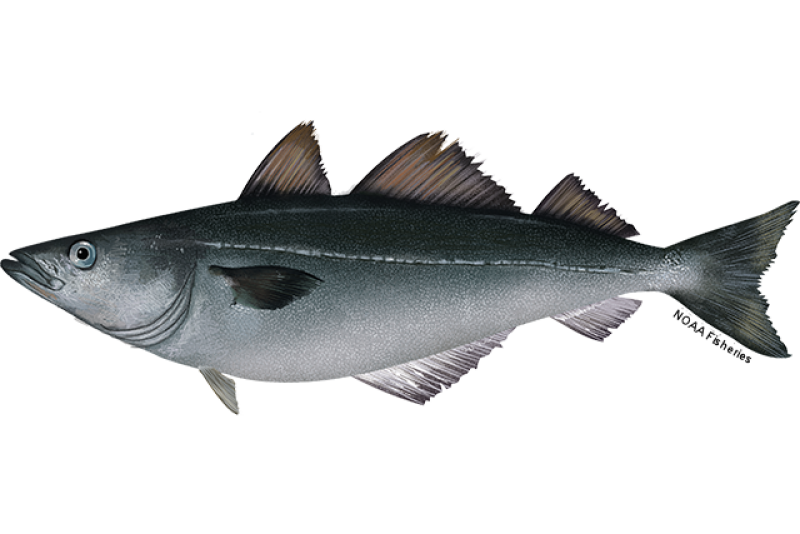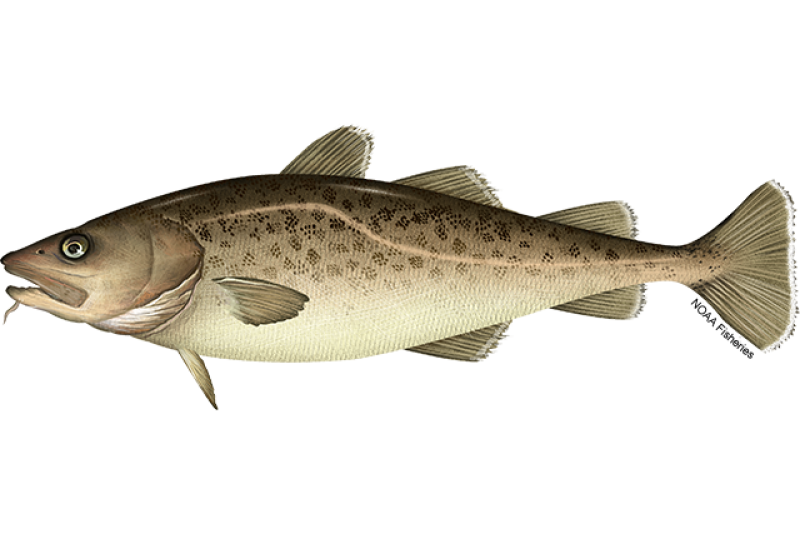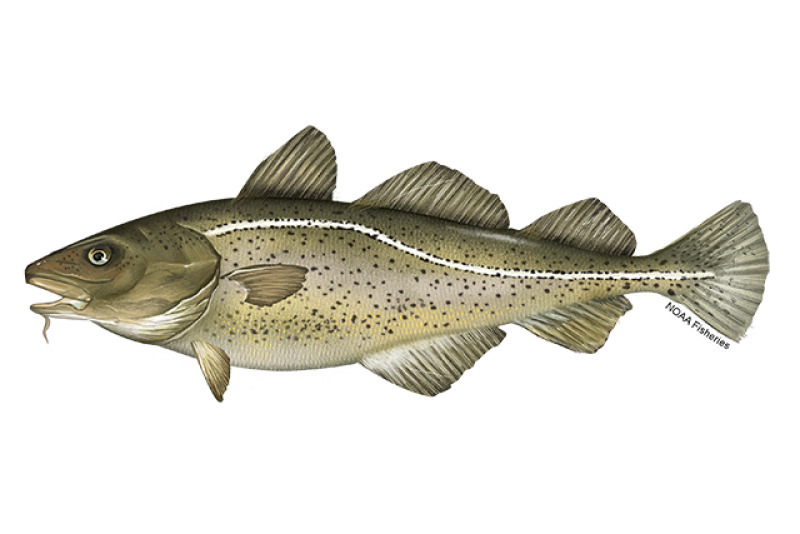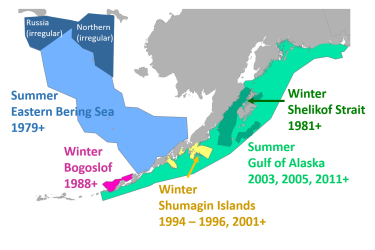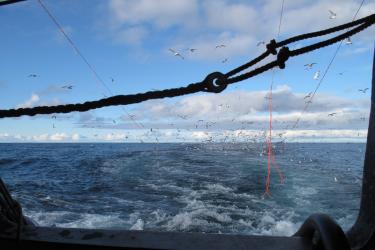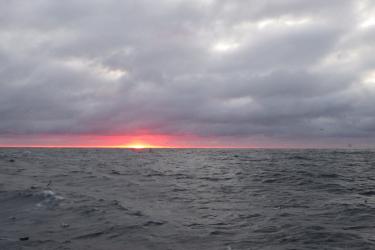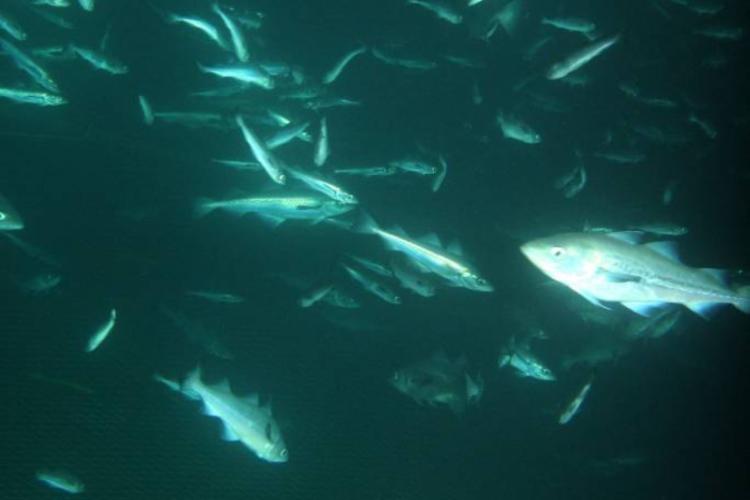 Subsurface water clarity has a major impact on marine ecosystems and commercially important species like Alaska pollock. Credit: NOAA Fisheries.
Subsurface water clarity has a major impact on marine ecosystems and commercially important species like Alaska pollock. Credit: NOAA Fisheries.
Subsurface water clarity has a major impact on marine ecosystems and commercially important species like Alaska pollock. Credit: NOAA Fisheries.
About the Species
 Subsurface water clarity has a major impact on marine ecosystems and commercially important species like Alaska pollock. Credit: NOAA Fisheries.
Subsurface water clarity has a major impact on marine ecosystems and commercially important species like Alaska pollock. Credit: NOAA Fisheries.
Subsurface water clarity has a major impact on marine ecosystems and commercially important species like Alaska pollock. Credit: NOAA Fisheries.
Alaska pollock—also known as walleye pollock—is a key species in the Alaska groundfish complex and a target species for one of the world's largest fisheries. Pollock is a semipelagic schooling fish widely distributed in the North Pacific Ocean with largest concentrations in the eastern Bering Sea.
U.S. wild-caught Alaska pollock is a smart seafood choice because it is sustainably managed and responsibly harvested under U.S. regulations.

Population
The Aleutian Islands, Eastern Bering Sea, and Western/Central/West Yakutat Gulf of Alaska stocks are not overfished. The Bogoslof and Southeast Gulf of Alaska population levels are unknown, but management measures are in place.

Fishing Rate
Not subject to overfishing.

Habitat Impact
The Alaska pollock fishery uses pelagic trawl gear that, although sometimes making contact with the bottom, have minimal impact on habitat.

Bycatch
The Alaska pollock fishery is one of the cleanest in terms of incidental catch of other species (less than 1 percent).
Population Status
- There are five stocks of walleye pollock: Aleutian Islands, Eastern Bering Sea, Western/Central/West Yakutat Gulf of Alaska, Bogoslof, and Southeast Gulf of Alaska. According to the most recent stock assessments:
- The Aleutian Islands stock is not overfished (2022 stock assessment), and not subject to overfishing based on 2023 catch data. Summary stock assessment information can be found on Stock SMART.
- The Eastern Bering Sea stock is not overfished (2023 stock assessment), and not subject to overfishing based on 2023 catch data. Summary stock assessment information can be found on Stock SMART.
- The Western/Central/West Yakutat Gulf of Alaska stock is not overfished (2023 stock assessment), and not subject to overfishing based on 2023 catch data. Summary stock assessment information can be found on Stock SMART.
- The Bogoslof stock has been assessed, but there is not enough information to determine the population size so the overfished status is unknown (2022 stock assessment). This stock is not subject to overfishing based on 2023 catch data. Summary stock assessment information can be found on Stock SMART.
- The Southeast Gulf of Alaska stock has been assessed, but there is not enough information to determine the population size so the overfished status is unknown (2023 stock assessment). This stock is not subject to overfishing based on 2023 catch data. Summary stock assessment information can be found on Stock SMART.
Appearance
- Pollock is a member of the cod family.
- They can grow as long as 3 feet but typically reach lengths between 12 and 20 inches and weigh between 1 and 3 pounds.
- They have speckled coloring that helps them blend in with the seafloor to avoid predators.
Biology
- Alaska pollock grow fast and have a relatively short life span of about 12 years.
- As a result, they are generally more productive compared to slower growing, longer living species.
- Some pollock begin to reproduce by the age of 3 or 4 and are extremely fertile, so each generation replaces aging or harvested fish in just a few years.
- In the spring, pollock migrate inshore to shallow water to breed and feed.
- They move back to warmer, deeper waters in the winter months.
- The survival of young pollock depends on several factors, such as the availability of food, environmental conditions, and predation.
- Their survival rate is highly variable, which can potentially cause large fluctuations in the abundance of pollock in a matter of a few years.
- Juvenile pollock eat zooplankton (tiny floating animals) and small fish.
- Older pollock feed on other fish, including juvenile pollock.
- Many other species—including Steller sea lions and other marine mammals, fish, and seabirds—feed on pollock and rely on them for survival.
Where They Live
Range
- Alaska pollock are found throughout the North Pacific Ocean but are most common in the Bering Sea.
Habitat
- Younger pollock live in the mid-water region of the ocean; older pollock (age 5 and up) typically dwell near the ocean floor.
- Pollock swim in large schools in waters between 330 and 985 feet deep but are sometimes found as deep as 3,300 feet.
Fishery Management
- NOAA Fisheries and the North Pacific Fishery Management Council manage the Alaska pollock fishery.
- Managed under the Groundfish Fishery Management Plans for the Gulf of Alaska and the Bering Sea/Aleutian Islands:
- The Alaska pollock fishery is a great example of how science-based management and monitoring can help ensure the long-term sustainability of the resource.
- The Bering Sea fishery is one of the first U.S. fisheries to be managed with catch shares and is often considered one of the best-managed fisheries in the world.
Harvest
- Commercial fishery:
- The Alaska pollock fishery is one of the most valuable in the world.
- In 2023, commercial landings of Alaska pollock from the Bering Sea and Gulf of Alaska totaled over 3 billion pounds and were valued at approximately $525 million, according to the NOAA Fisheries commercial fishing landings database.
- A quarter of pollock products are surimi (imitation crab), almost one-fifth is roe (eggs), and close to half are fillets.
- The majority of the U.S. catch of pollock comes from the Bering Sea.
- Gear types, habitat impacts, and bycatch:
- In the United States, pollock are caught by trawlers that tow a large cone-shaped net through the mid-water.
- Less than 1 percent of the total catch in the Alaska pollock fishery is made up of other species.
- Bycatch of Pacific salmon is a particular concern because of its importance to commercial and subsistence fisheries. The relative impact of the pollock fishery on critical salmon runs has been estimated to be relatively low, especially since 2007.
- 100 percent of pollock fishing boats in the Bering Sea carry scientifically trained observers. They carefully monitor and count all Pacific salmon caught incidentally in the pollock nets. These salmon have never been allowed to be landed or sold by the pollock fishery but, when feasible, they are donated to local Alaska food banks.
- The North Pacific Fishery Management Council implemented measures in 2011 to increase incentives for fishermen to further reduce Chinook salmon bycatch.
- The pollock industry has developed several innovative approaches to meet these new requirements, including using NOAA Fisheries Observer program data to close salmon bycatch hotspots to fishing on a weekly basis and testing a new salmon excluder device for trawl nets.
- The Council improved the management of Chinook and chum salmon bycatch in the Bering Sea by creating a comprehensive salmon bycatch avoidance program in 2016, and continues to examine additional measures to minimize salmon bycatch.
Scientific Classification
- Alaska pollock are found throughout the North Pacific Ocean but are most common in the Bering Sea.
- Younger pollock live in the mid-water region of the ocean; older pollock (age 5 and up) typically dwell near the ocean floor.
- Pollock swim in large schools in waters between 330 and 985 feet deep but are sometimes found as deep as 3,300 feet.
Fishery Management
- NOAA Fisheries and the North Pacific Fishery Management Council manage the Alaska pollock fishery.
- Managed under the Groundfish Fishery Management Plans for the Gulf of Alaska and the Bering Sea/Aleutian Islands:
- The Alaska pollock fishery is a great example of how science-based management and monitoring can help ensure the long-term sustainability of the resource.
- The Bering Sea fishery is one of the first U.S. fisheries to be managed with catch shares and is often considered one of the best-managed fisheries in the world.
Harvest
- Commercial fishery:
- The Alaska pollock fishery is one of the most valuable in the world.
- In 2023, commercial landings of Alaska pollock from the Bering Sea and Gulf of Alaska totaled over 3 billion pounds and were valued at approximately $525 million, according to the NOAA Fisheries commercial fishing landings database.
- A quarter of pollock products are surimi (imitation crab), almost one-fifth is roe (eggs), and close to half are fillets.
- The majority of the U.S. catch of pollock comes from the Bering Sea.
- Gear types, habitat impacts, and bycatch:
- In the United States, pollock are caught by trawlers that tow a large cone-shaped net through the mid-water.
- Less than 1 percent of the total catch in the Alaska pollock fishery is made up of other species.
- Bycatch of Pacific salmon is a particular concern because of its importance to commercial and subsistence fisheries. The relative impact of the pollock fishery on critical salmon runs has been estimated to be relatively low, especially since 2007.
- 100 percent of pollock fishing boats in the Bering Sea carry scientifically trained observers. They carefully monitor and count all Pacific salmon caught incidentally in the pollock nets. These salmon have never been allowed to be landed or sold by the pollock fishery but, when feasible, they are donated to local Alaska food banks.
- The North Pacific Fishery Management Council implemented measures in 2011 to increase incentives for fishermen to further reduce Chinook salmon bycatch.
- The pollock industry has developed several innovative approaches to meet these new requirements, including using NOAA Fisheries Observer program data to close salmon bycatch hotspots to fishing on a weekly basis and testing a new salmon excluder device for trawl nets.
- The Council improved the management of Chinook and chum salmon bycatch in the Bering Sea by creating a comprehensive salmon bycatch avoidance program in 2016, and continues to examine additional measures to minimize salmon bycatch.
Scientific Classification
| Kingdom | Animalia | Phylum | Chordata | Class | Actinopterygii | Order | Gadiformes | Family | Gadidae | Genus | Gadus | Species | chalcogrammus |
|---|
Last updated by NOAA Fisheries on 06/10/2025
Featured News
 Celebrate Culinary Arts Month with a sustainable seafood recipe for every month of the year.
Celebrate Culinary Arts Month with a sustainable seafood recipe for every month of the year.
What Your Birth Month Says About Your Next Seafood Recipe
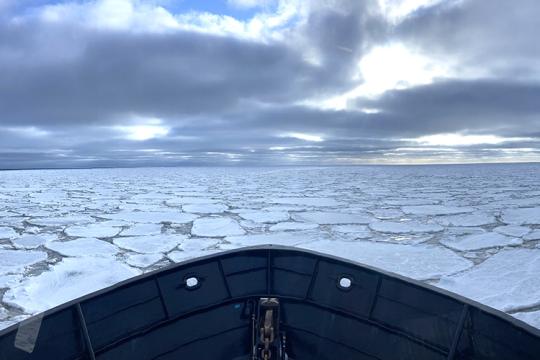 The research vessel Norseman II pushes carefully through the ice, maneuvering for open water. Credit: Gavin M Brady/NOAA Fisheries.
The research vessel Norseman II pushes carefully through the ice, maneuvering for open water. Credit: Gavin M Brady/NOAA Fisheries.
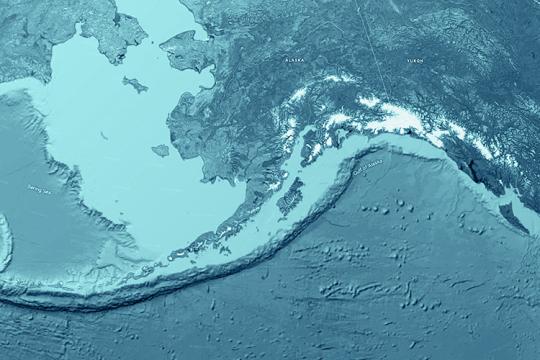 3D render and imaging of topographic map of Alaska showing the Gulf of Alaska, Aleutian Islands and Bering Sea. Satellite images courtesy of NASA. Credit: Frank Ramspott
3D render and imaging of topographic map of Alaska showing the Gulf of Alaska, Aleutian Islands and Bering Sea. Satellite images courtesy of NASA. Credit: Frank Ramspott
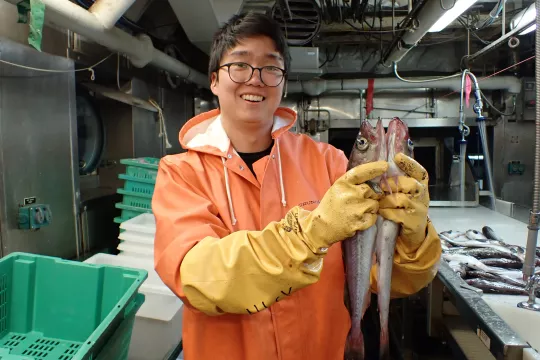 Teacher at Sea Nick Lee compares the lengths of two pollock aboard NOAA Ship Oscar Dyson.
Teacher at Sea Nick Lee compares the lengths of two pollock aboard NOAA Ship Oscar Dyson.
Seafood Facts

Is Alaska Pollock Sustainable?
U.S. wild-caught Alaska pollock is a smart seafood choice because it is sustainably managed and responsibly harvested under U.S. regulations.
Availability
Fresh from January to April and June to October. Frozen year-round.
Source
U.S. wild-caught, mainly in the Bering Sea and Gulf of Alaska.
Taste
Pollock has mild-tasting flesh and is similar to other white fish like cod or haddock.
Texture
Pollock has a relatively fine texture and is well suited for a variety of preparations.
Health Benefits
Alaska pollock is a good source of omega-3 fatty acids, high in protein, and low in carbohydrates and fat.
Nutrition Facts
Servings: 1; Serving Weight: 100 g (raw); Calories: 81; Protein: 17.18 g; Total Fat: 0.8 g; Total Saturated Fatty Acids: 0.164 g; Carbohydrate: 0 g; Total Sugars: 0 g; Total Dietary Fiber: 0 g; Cholesterol: 71 mg; Selenium: 21.9 mcg; Sodium: 99 mgPollock Recipes
Looking for some ways to add pollock into your rotation? If you need cooking inspiration, browse these recipes for creamy pollock enchiladas, pollock street tacos, and more!

Last updated by NOAA Fisheries on 06/10/2025
Seafood News
 Celebrate Culinary Arts Month with a sustainable seafood recipe for every month of the year.
Celebrate Culinary Arts Month with a sustainable seafood recipe for every month of the year.
What Your Birth Month Says About Your Next Seafood Recipe
 Fresh-caught taʻape on ice. Credit: Conservation International Hawaiʻi.
Fresh-caught taʻape on ice. Credit: Conservation International Hawaiʻi.
Reducing Waste and Feeding Communities in Hawaiʻi with a Whole Fish Approach
 Chef Tyler Hadfield’s Curried Skate Wings with Tomato-Masala Chutney
Chef Tyler Hadfield’s Curried Skate Wings with Tomato-Masala Chutney
Ring In the New Year With These Crowd-Favorite Seafood Recipes
 NOAA Fisheries, in collaboration with Blue Ocean Mariculture, is conducting a multi-year pilot study to evaluate observational methods and tools for studying Hawaiian monk seal behavior. Courtesy of Blue Ocean Mariculture
NOAA Fisheries, in collaboration with Blue Ocean Mariculture, is conducting a multi-year pilot study to evaluate observational methods and tools for studying Hawaiian monk seal behavior. Courtesy of Blue Ocean Mariculture
AI Meets Aquaculture to Study Hawaiian Monk Seal Interactions With Net Pens
Management Overview
The United States manages pollock as five separate stocks:
- Eastern Bering Sea stock (Unimak Pass to the U.S.–Russia Convention line)
- Aleutian Islands stock (Aleutian Islands shelf region from 170 degrees W. to the U.S.–Russia Convention line)
- Central Bering Sea–Bogoslof Island stock
- Central/Western/West Yakutat stock in the Gulf of Alaska
- Southeast Outside stock in the Gulf of Alaska
The American Fisheries Act (1998) established eligibility to participate in the BSAI pollock fishery and permanent allocations of pollock quota among sectors. Community Development Quota groups are allocated 10 percent of Eastern Bering Sea pollock total allowable catch. The remaining TAC is divided up as follows:
- 50 percent to catcher vessels delivering inshore
- 40 percent to catcher/processors offshore
- 10 percent to catcher vessels delivering to motherships
The Consolidated Appropriations Act of 2004 (PDF, 455 pages) established that the non-CDQ pollock fishery in the Aleutian Islands is fully allocated to the Aleut Corporation, for the purpose of the economic development in Adak, with a percentage allocated to vessels 60 feet or less in length overall. Since 1992, the Gulf of Alaska pollock has been allocated to reduce potential impacts on steller sea lions. In 2005, Amendment 82 to the Fishery Management Plan for Groundfish of the Bering Sea and Aleutian Islands Management Area established a framework for the management of the Aleutian Islands subarea pollock fishery.
Last updated by NOAA Fisheries on 06/10/2025
Science Overview

NOAA Fisheries conducts various research activities on the biology, behavior, and population health of Alaska pollock. The results of this research are used to inform management decisions for this species. For detailed information about stock status, management, assessments, and resource trends, you can search for Alaska pollock, and any other species of interest, using NOAA’s StockSMART web tool.
Alaska Pollock Research in Alaska
Research and management of Alaska pollock stocks are considered world-class and an example of how science-based management can ensure sustainability. Scientists at the Alaska Fisheries Science Center collect and analyze the data that managers need to set sustainable catch limits.
Surveying Pollock Populations
We gather information about the number, location, and age of pollock in Alaskan waters during annual surveys using acoustic technology, pelagic trawls, and bottom trawls. These data are combined with information collected by fishery observers. Managers use the data from these surveys, along with information about the fishery and species, to determine how much pollock can be harvested every year and to make other management decisions.
The Alaska Department of Fish and Game also surveys nearshore bottom areas using trawls in the Gulf of Alaska (primarily to monitor crab stocks). Data from these surveys also contribute to estimating pollock abundance.
Pollock in the Gulf of Alaska, eastern Bering Sea, and Aleutian Islands are managed as separate stocks based on the results of genetic studies, biological characteristics, and analyses of larval drift patterns from spawning locations
Early Life Studies
We study factors affecting young pollock survival to recruitment (when they reach a size available to the fishery at around 3 years old). These survival rates can vary dramatically from one year to the next and this affects pollock populations, posing challenges for the fishery and fishery managers. Scientists have linked these ups and downs to variability in environmental conditions during the early life of pollock.
Understanding how young pollock respond to environmental changes helps scientists understand and communicate future uncertainty in population size and hence size of eventual fishing quotas to managers, the public, and fishery stakeholders
Age and Growth
We determine the age of individual fish to provide data for age-structured modeling of populations and continue to develop new techniques to age walleye pollock.
An Ecosystem Approach
Environmental factors affect walleye pollock populations in the Eastern Bering Sea, Aleutian Islands, and Gulf of Alaska. Prey availability and the number of fish, seabird, and marine mammal predators and their spatial overlap with pollock also have a large impact. Comprehensive scientific observer coverage aboard commercial fishing vessels closely monitors catch and bycatch to help gauge possible impacts of humans and the fishery on the ecosystem. Our scientists work closely with industry and managers to mitigate potential adverse impacts through a variety of conservation and management measures, and by developing appropriate gear modifications.
Each year, a comprehensive ecosystem status report on climate and fishing is compiled in Ecosystem Assessments and Report Cards. These reports are an important step towards achieving the ecosystem-based management goals of the North Pacific Fishery Management Council: to maintain predator-prey relationships, diversity, and habitat, and to monitor effects of climate change.

Assessing Past, Present, and Future Pollock Stocks
We create Stock Assessment and Fishery Evaluation (SAFE) reports to summarize the best available scientific information concerning the past, present, and possible future condition of stocks, marine ecosystems, and fisheries that are managed under federal regulation, including the walleye pollock fishery. These reports provide information to the North Pacific Fishery Management Council for determining annual harvest levels from each stock; documenting significant trends or changes in the resource, marine ecosystems, and fishery over time; and assessing the relative success of existing state and Federal fishery management programs.
More Information
- Alaska Fish Research Surveys
- Age and Growth Procedures for Otolith Examination
- Age Reading Interactive Demonstration
- Fish Species Maximum Age Data
- Groundfish Catch Percentage and Value
- Resource Ecology and Ecosystem Modeling, Number of Stomachs Database
- Alaska Ichthyoplankton Information System Database
Recent Science Blogs
Last updated by NOAA Fisheries on 06/10/2025
Documents
Profiles of Fishing Communities of Alaska
In-depth profiles of the 196 Alaska communities most involved in Alaskan and North Pacific…
Aleutian Islands Pollock Program Cost Recovery
Reports summarizing costs directly related to management of the Aleutian Islands Pollock fishery…
American Fisheries Act Pollock Program Cost Recovery Reports
Annual reviews of cost recovery and fee payments in Alaska for the American Fisheries Act (AFA)…
Environmental Assessment/Regulatory Impact Review for Proposed Amendment 109 to the Fishery Management Plan for Gulf of Alaska Groundfish and a Proposed Regulatory Amendment - Modifications to Gulf of Alaska Pollock and Pacific Cod Seasonal Allocation
Analysis of modifications to allocations of pollock and cod to allow fisheries to more fully…
Data & Maps
2024 Gulf Of Alaska Ecosystem Status Report: In Brief
This assessment summarizes and synthesizes climate, biological, and fishing effects on the shelf…
Ecosystem Status Report 2024 Gulf of Alaska
This assessment summarizes and synthesizes climate, biological, and fishing effects on the shelf…
2024 Aleutian Islands Ecosystem Status Report: In Brief
This assessment summarizes and synthesizes historical climate and fishing effects on the shelf and…
Ecosystem Status Report 2024 Aleutian Islands
This assessment summarizes and synthesizes historical climate and fishing effects on the shelf and…
Research
Acoustic-Trawl and Optical Surveys and Research in Alaska
The Midwater Assessment and Conservation Engineering Program supports fisheries management through world-class applied science, technology, gear, and data-driven research.
2023 North Pacific Groundfish Stock Assessments
2023 North Pacific Groundfish Stock Assessment and Fishery Evaluation Reports for 2024 Fisheries
2022 North Pacific Groundfish Stock Assessments
2022 North Pacific Groundfish Stock Assessment and Fishery Evaluation Reports for 2023 Fisheries
North Pacific Groundfish Stock Assessments and Fishery Evaluation Reports
Alaska Groundfish Stock Assessments, Economic Status Reports, and Ecosystem Status Reports.
Outreach & Education
2025 Winter Acoustic-Trawl Pre-spawning Pollock Surveys in the Gulf of Alaska
Research brief for Acoustic-Trawl pollock survey.
Research Brief: 2023 EcoFOCI Juvenile Groundfish and Forage Fish Survey
Scientists from the Recruitment Processes Program at the Alaska Fisheries Science Center are…
EcoFOCI Spring Ichthyoplankton Survey
This is a flyer that describes the annual EcoFOCI Spring Ichthyoplankton Survey.
Summer Acoustic-Trawl Survey of Walleye Pollock in the Gulf of Alaska Research Brief 2023
This is a flyer that describes the summer pollock survey in the Gulf of Alaska for 2023.
Last updated by NOAA Fisheries on 06/10/2025


